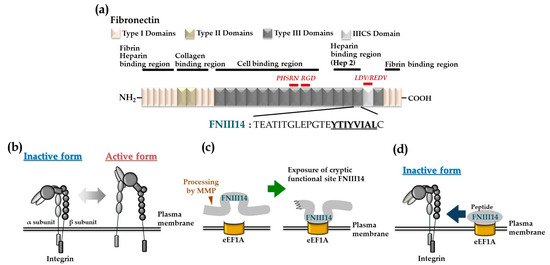Biofunctional peptide FNIII14, which is derived from the 14th fibronectin (FN) type III-like (FN-III) repeat of FN molecule, is capable of inhibiting cell adhesion to the extracellular matrix (ECM). This functional site is usually buried within the molecular structure of FN, but can be exposed by conformational changes and proteolytic cleavage. Peptide FNIII14 can induce a conformational change in β1-integrin from the active to the inactive form, causing functional inactivation. Based on this anti-adhesive activity, peptide FNIII14 exhibits therapeutic potential for several diseases such as metabolic diseases, organ fibrosis, and malignant tumors. Peptide FNIII14 blocks integrin-mediated signaling by a mechanism entirely distinct from that of conventional antagonisitic peptides, including Arg-Gly-Asp peptides that competitively inhibit the ECM binding of integrin.
Extracellular matrix (ECM) protein molecules harbor functional sites within their molecular structures
[1]. Some, such as sites for cell adhesion, including integrin-binding sites represented by the Arg-Gly-Asp (RGD) motif of fibronectin (FN) and vitronectin, are exposed on the surface of protein molecules
[2]. In contrast, other functional sites are often buried within the molecular structure of ECM proteins
[3]. These cryptic functional sites, referred to as matricryptic sites, are exposed through proteolytic cleavage by proteinases during tissue remodeling. They also become functional by structural unfolding through cell adhesion and interaction with other ECM components in response to temporal and spatial changes in the microenvironment
[3]. Peptides/fragments containing these matricryptic functional sites have unique biological activities not often detected in the parent molecules
[1][3][4].
FN, an abundant and ubiquitous ECM protein, is an essential cell adhesion protein, and has several integrin-binding sites, which provide a scaffold for adhesion to various types of cells. Two types of FN are present in vertebrates: soluble FN produced by hepatocytes secreted into plasma (plasma FN), and an insoluble form of FN, which is the major component of the ECM (cellular FN)
[5]. Both FN molecules not only play important roles in wound healing as cell adhesion substrates but can also regulate fundamental cellular functions, including cell survival, proliferation, differentiation, and migration. Several adhesion sequences within the FN molecule have been intensively studied
[6][7], including the sequences Leu–Asp–Val (LDV) and Arg-Glu-Asp-Val (REDV) in the type III connecting segment (IIICS) domain, which are recognized by integrin α4β1, as well as the sequence Pro-His-Ser-Arg-Asn (PHSRN) and RGD in the 9th and 10th type III repeat, respectively, both of which are recognized by integrin α5β1. FN contains fibrin-, heparin-, collagen-, and cell-binding domains, each of which comprises type I, II, and III repeats (
Figure 1a). Given its versatile domains and structure, FN plays a central role in ECM–cell interactions and mediates flexible signaling via these interactions.
Figure 1. The fibronectin-derived functional peptide FNIII14. (
a) Schematic representation of human fibronectin and the amino acid sequence of the anti-adhesion peptide FNIII14. (
b) Conformational regulation of integrin structure. (
c) Exposure of the cryptic anti-adhesive site of FNIII14 within the FN molecule by matrix metalloproteinase (MMP) processing. (
d) Peptide FNIII14 induces a conformational change in integrin from the active to an inactive state via its putative membrane receptor eukaryotic elongation factor 1A (eEF1A). Figures modified and revised from
[8].
However, the FN molecule is susceptible to proteolytic degradation by inflammatory proteinases, such as matrix metalloproteinases (MMPs) and thrombin, exposing the matricryptic sites as bioactive peptides exhibiting a variety of biological functions
[1][4][8]. We found that FN harbors a matricryptic site with the amino acid sequence YTIYVIAL within the 14th FN type III domain. This site inhibits cell adhesion to the ECM. This cryptic anti-adhesion site is exposed by the interaction of the carboxyl-terminal heparin-binding domain (Hep 2) with ECM components containing sulfated sugars such as heparin. Peptide FNIII14, a 22-mer FN peptide containing this site, can induce conformational change in β1-integrin from the active to the inactive form, resulting in functional inactivation.

